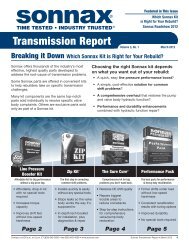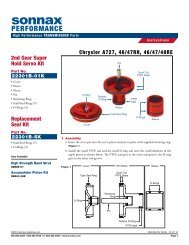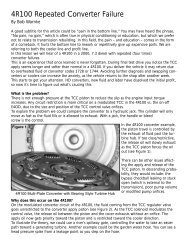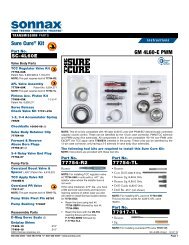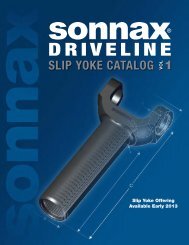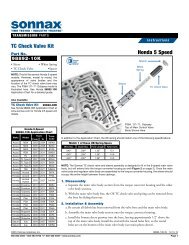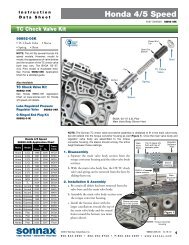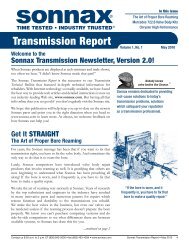4T65E All Wheel Drive Problems Noise and Gear Failures - Sonnax
4T65E All Wheel Drive Problems Noise and Gear Failures - Sonnax
4T65E All Wheel Drive Problems Noise and Gear Failures - Sonnax
Create successful ePaper yourself
Turn your PDF publications into a flip-book with our unique Google optimized e-Paper software.
<strong>4T65E</strong> <strong>All</strong> <strong>Wheel</strong> <strong>Drive</strong> <strong>Problems</strong><br />
<strong>Noise</strong> <strong>and</strong> <strong>Gear</strong> <strong>Failures</strong><br />
By Ed Lee<br />
The 4T65-E was introduced in 1997 in several vehicles equipped with the supercharged 3.8L engine,<br />
<strong>and</strong> some non-supercharged 3.4L <strong>and</strong> 3.8L engines. It was considered to be the big brother to the<br />
4T60-E transaxle.<br />
The differential for the front-wheel-drive<br />
4T65-E rests between the final drive<br />
ring gear <strong>and</strong> the final drive housing.<br />
Since the differential is free to move<br />
between these two members, its end<br />
play must be regulated. The parameters<br />
for the end play are a minimum of .005”<br />
<strong>and</strong> a maximum of .025”, <strong>and</strong> final drive<br />
selective thrust washers are used to<br />
adjust this measurement. There are 10<br />
different selective thrust washers ranging<br />
from .055” to .095” thick, <strong>and</strong> they<br />
are installed just as they have been<br />
since the introduction of GM’s first frontwheel<br />
transaxle, the 125. In 1999 an<br />
all-wheel-drive version of the 4T65-E<br />
was offered in the 3.4L Montana.<br />
Except for the differential, the all-wheel-drive 4T65-E transmission is the same as the all-wheel-drive.<br />
The drive gear for the all-wheel-drive section is mounted to the differential housing near where the<br />
reluctor was mounted on the front-wheel-drive differential.<br />
When power is transmitted through gear-to-gear contact, the end play of the gears must be as close<br />
to zero as possible. For this reason, the differential of the all-wheel-drive 4T65-E is attached to the<br />
transfer case housing. The end of the differential is threaded, <strong>and</strong> a large nut is used to secure the<br />
differential to a bearing in the housing. Since the differential is affixed to the housing, the end play of<br />
the mating parts must be adjusted inboard of the differential. This is done by moving the selective<br />
thrust washer to a new position, at the drive end of the differential. Material is removed from the<br />
parking gear <strong>and</strong> the selective washer is s<strong>and</strong>wiched between the parking gear <strong>and</strong> the final drive<br />
sun gear.<br />
Figure 2<br />
Figure 1<br />
The all-wheel-drive differential.<br />
Two different types of parking gears. The thicker (taller)<br />
is for the front-wheel-drive <strong>and</strong> the thinner is for<br />
the all-wheel-drive.<br />
There are 21 different selective<br />
washers ranging from .061” to<br />
.105” thick. The end play is<br />
checked in the same manner<br />
as the clutch clearance is<br />
checked in the rear-wheeldrive<br />
Chrysler overdrives. If<br />
you follow the directions correctly,<br />
you will end up with an
end play between .020” <strong>and</strong> .024”. The<br />
selective thrust washers for the all-wheeldrive<br />
transaxles do not have a full circle I.D<br />
like the front-wheel-drive washers.<br />
The five locating tabs on the all-wheeldrive<br />
washers only center the washers on<br />
the sun gear shaft. The washers are free to<br />
rotate on the shaft, <strong>and</strong> since the shaft is<br />
considerably harder than the washers, they<br />
wear quickly. The material that the shaft<br />
removes from the washers passes through<br />
the gears of the differential <strong>and</strong> causes<br />
damage similar to that seen in Figure 1. At<br />
this point, replacing the selective washer<br />
with an OE replacement is your only option.<br />
However, if you are really lucky, you may<br />
find a front-wheel-drive parking gear that is<br />
the same thickness as the combined thicknesses<br />
of the selective washer <strong>and</strong> the allwheel-drive<br />
park gear. Another alternative<br />
is to find a front-wheel-drive park gear that Selective thrust washers showing signs of wear.<br />
is thicker than the washer <strong>and</strong> gears combined<br />
<strong>and</strong> have it machined to the proper thickness. Either way will work, <strong>and</strong> you will be safer than<br />
using the OE washer.<br />
Special thanks to the crew at Deltrans for their assistance in preparing this article.<br />
Ed Lee is a <strong>Sonnax</strong> Technical Specialist <strong>and</strong> a member of the TASC Force (Technical Automotive<br />
Specialties Committee), a group of recognized industry technical specialists, transmission rebuilders<br />
<strong>and</strong> <strong>Sonnax</strong> Industries Inc. technicians.<br />
©2005 <strong>Sonnax</strong><br />
Figure 3<br />
Front <strong>and</strong> all-wheel-drive selective thrust washers.<br />
Figure 4



